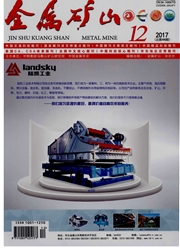

 中文摘要:
中文摘要:
预先击碎强风技术被用来在房顶控制正式就职探穴区域。钥匙是形成预先击碎缝接并且预言缝接的效果。H-J-C 强风模型在房顶被造。基于动态力量和动态岩石的失败标准的理论,岩石动态损坏和进化预先击碎缝接被张力的损坏模仿并且砍模型的失败。根据在 Tongkeng 矿的号码 92 矿石身体测试采矿场的实际状况,预先击碎强风缝接的形成进程被 Ansys/Ls-dyna 软件模仿,预先击碎缝接被数字全景的地上凿穿的一个系统检查照相机。预先击碎缝接被数字全景的地上凿穿的系统在房顶检查。数字模拟和检查的结果证明在洞前的中心的线,张力的压力的最小到达 20 MPa,它比岩石的动态张力的力量的 13.7 MPa 大得多。最小的粒子颤动速度到达 50 cm/s,它比许可的颤动速度的 3040 cm/s 大。岩石在中心线附近被破坏,预先击碎被大直径成功地形成,大距离预先击碎,这被表明在房顶的洞。
 英文摘要:
英文摘要:
The pre-crack blast technology has been used to control the induction caving area in the roof. The key is to form the pre-crack seam and predict the effect of the seam. The H-J-C blast model was built in the roof. Based on the theories of dynamic strength and failure criterion of dynamic rock, the rock dynamic damage and the evolution of pre-crack seam were simulated by the tensile damage and shear failure of the model. According to the actual situation of No. 92 ore body test stope at Tongkeng Mine, the formation process of the pre-crack blast seam was simulated by Ansys/Ls-dyna software, the pre-crack seam was inspected by a system of digital panoramic borehole camera. The pre-crack seam was inspected by the system of digital panoramic borehole in the roof. The results of the numerical simulation and inspection show that in the line of centers of pre-hole, the minimum of the tensile stress reaches 20 MPa, which is much larger than 13.7 MPa of the dynamic tensile strength of rock. The minimum particle vibration velocity reaches 50 cm/s, which is greater than 30-40 cm/s of the allowable vibration velocity. It is demonstrated that the rock is destroyed near the center line and the pre-crack is successfully formed by the large diameters and large distances pre-crack holes in the roof.
 同期刊论文项目
同期刊论文项目
 同项目期刊论文
同项目期刊论文
 期刊信息
期刊信息
